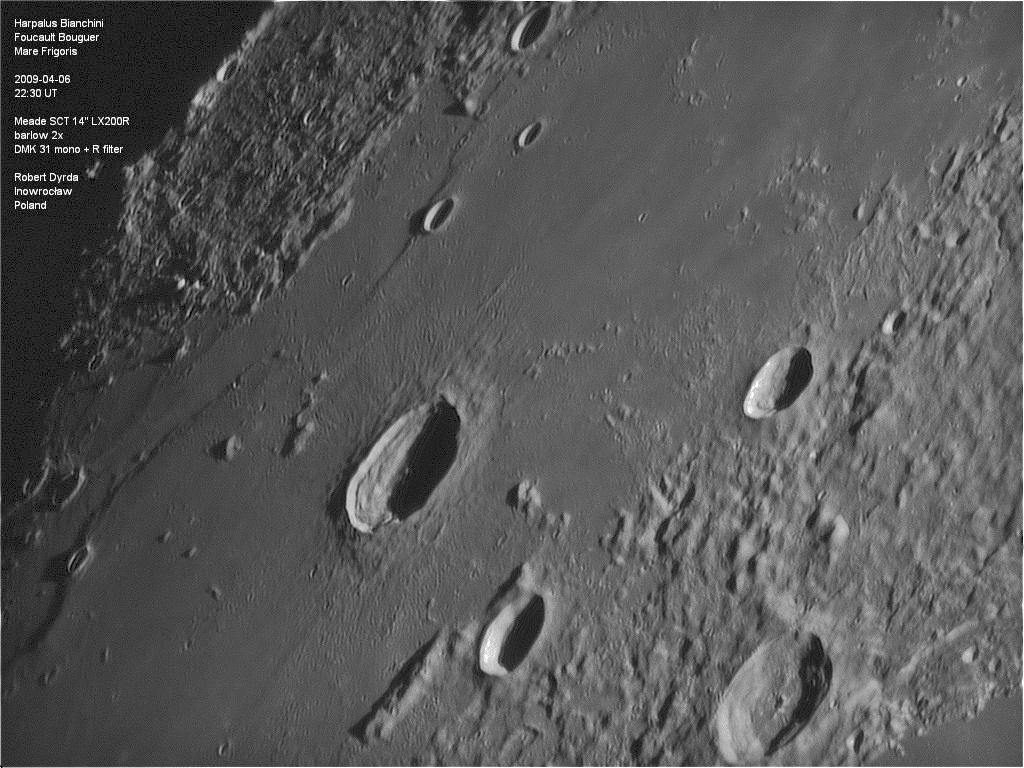Difference between revisions of "April 13, 2009"
(Created page with "__NOTOC__ =Three Things To Notice= <!-- ws:start:WikiTextHeadingRule:2:<h1> --> <!-- ws:start:WikiTextLocalImageRule:8:<img src="/file/view/LPOD-Apr13-09.jpg/...") |
|||
| Line 6: | Line 6: | ||
<em>image by [mailto:oberon@oberon.pl Robert Dyrda], Inowroclaw, Poland</em><br /> | <em>image by [mailto:oberon@oberon.pl Robert Dyrda], Inowroclaw, Poland</em><br /> | ||
<br /> | <br /> | ||
| − | An infrequently imaged crater is always a treat, and Robert's excellent view of Harpalus and the region of western Mare Frigoris provides new data for description and speculation. [http://the-moon.wikispaces.com/Harpalus Harpalus] is known to be a young crater and its ejecta and secondaries are well documented in this image. But immediately on looking at this it seemed to me that the ejecta is not scattered equally in all directions - it is most conspicuous to the north and the south of the crater and much weaker to the east and west. This is a sign of oblique impact, but the Clementine higher Sun [mailto:tychocrater@yahoo.com Chuck Wood]</em><br /> | + | An infrequently imaged crater is always a treat, and Robert's excellent view of Harpalus and the region of western Mare Frigoris provides new data for description and speculation. [http://the-moon.wikispaces.com/Harpalus Harpalus] is known to be a young crater and its ejecta and secondaries are well documented in this image. But immediately on looking at this it seemed to me that the ejecta is not scattered equally in all directions - it is most conspicuous to the north and the south of the crater and much weaker to the east and west. This is a sign of oblique impact, but the Clementine higher Sun [http://www.mapaplanet.org/explorer-bin/explorer.cgi?map=Moon&layers=moon_clementine_bw&west=310.97&south=50.16&east=322.22&north=55.23&center=316.595&defaultcenter=on&grid=none&stretch=none&projection=SIMP&advoption=NO&info=NO&resolution=64 image] does not suggest that the rays are asymmetrically distributed. Hmm. Are secondaries and similar ejecta more sensitive to angle of impact than rays? It wouldn't seem so since rays are also ejecta... Perhaps the most dramatic feature in this image is the contrast between the relatively smooth mare surface and the very rough texture of the crater [http://the-moon.wikispaces.com/R%C3%BCkl+2 South] at the upper left. South is full of Imbrium ejecta, which here is a mega-gravel of small mountains and hills. A much less conspicuous feature is the small sinuous rille near the upper right corner. At first I thought this was the rille north of [http://www.lpod.org/archive/LPOD-2005-05-18.htm Sharp], but then realized it is a different one. Both rilles are very similar, starting in collapse depressions. Sinuous rilles in non-mare material are uncommon, but these two are joined by ones both east and west of the rim of [http://www.lpod.org/coppermine/displayimage.php?pid=699&fullsize=1 Plato]. Since most sinuous rilles occur in mare lavas, I wildly speculate that the existence of four in the Plato to Sharp arc of Imbrium ejecta implies that the ejecta is underlain by older mare material. <br /> |
| + | <br /> | ||
| + | <em>[mailto:tychocrater@yahoo.com Chuck Wood]</em><br /> | ||
<br /> | <br /> | ||
<strong>Technical Details</strong><br /> | <strong>Technical Details</strong><br /> | ||
Revision as of 19:38, 1 January 2015
Three Things To Notice

image by Robert Dyrda, Inowroclaw, Poland
An infrequently imaged crater is always a treat, and Robert's excellent view of Harpalus and the region of western Mare Frigoris provides new data for description and speculation. Harpalus is known to be a young crater and its ejecta and secondaries are well documented in this image. But immediately on looking at this it seemed to me that the ejecta is not scattered equally in all directions - it is most conspicuous to the north and the south of the crater and much weaker to the east and west. This is a sign of oblique impact, but the Clementine higher Sun image does not suggest that the rays are asymmetrically distributed. Hmm. Are secondaries and similar ejecta more sensitive to angle of impact than rays? It wouldn't seem so since rays are also ejecta... Perhaps the most dramatic feature in this image is the contrast between the relatively smooth mare surface and the very rough texture of the crater South at the upper left. South is full of Imbrium ejecta, which here is a mega-gravel of small mountains and hills. A much less conspicuous feature is the small sinuous rille near the upper right corner. At first I thought this was the rille north of Sharp, but then realized it is a different one. Both rilles are very similar, starting in collapse depressions. Sinuous rilles in non-mare material are uncommon, but these two are joined by ones both east and west of the rim of Plato. Since most sinuous rilles occur in mare lavas, I wildly speculate that the existence of four in the Plato to Sharp arc of Imbrium ejecta implies that the ejecta is underlain by older mare material.
Chuck Wood
Technical Details
See image margin
Related Links
Rükl plate 2
COMMENTS?
Click on this icon File:PostIcon.jpg at the upper right to post a comment.



